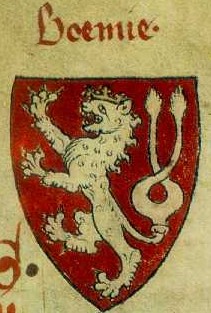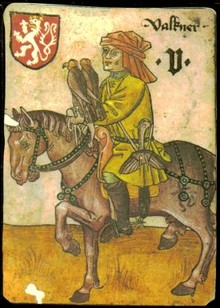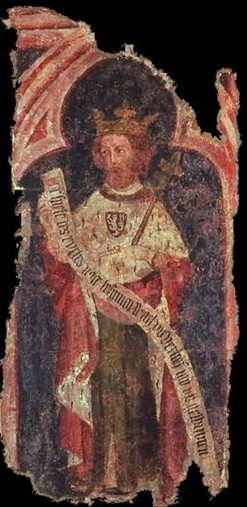The complete text of the book is available online, the major passage to playing cards is at page 242.
|
From Page 242: "Auch ein Kartenmaler namens Jonathan Kraysel aus Nürnberg kommt
1354 in Prag vor. Ob sich vordem schon ähnliche Künstler in Prag befanden,
oder ob die Spielkarten von den Schilderern geliefert wurden, kann
nicht diplomatisch nachgewiesen werden (Note 278). Die ältesten zuverlässigen Nachrichten vom Gebrauche der Spielkarten in Böhmen finden sich im Jahre 1340 vor, allein solche schon früher, wie dies Urkunden darthun, von polnischen Edelleuten zum Zeitvertreibe angewendet wurden, so ist es auch wahrscheinlich, dass diese Spielblätter, wie bereits bemerkt, schon unter König Johann, zu welcher Zeit sie die Höflinge in Frankreich kennen gelernt haben, in Böhmen bekannt gewesen sind. Ob man solche aber damals in Böhmen selbst und von welchen Leuten verfertigt halfe, oder ob sie durch fremde Kaufleute nach Böhmen gebracht wurden, dies lässt sich nicht bestimmen; genug, wir sind für jetzt dahin angewiesen, zu glauben, dass der erste Kartenmacher der aus, Nürnberg gekommene Künstler gewesen sei." (Note 278) "Unter den gangbaren Spielen, die in den königl. Verboten namentlich angeführt werden, und für die es schon unter K. Johann Unterrichtsanstalten gab, befinden sich verschiedene, deren Beschaffenheit nicht zu ermitteln ist. Würfel und Kugeln gehörten zu den verbotenen; Karten zu den erlaubten. Um der Spielsucht Einhalt zu thun, die damals unter den Jüngern Bürgern immer mehr einriss, verordnete Karl, wer immer im Würfelspiel verloren, der sollte durch volle 3 Jahre das Recht haben, den Verlust zurück zu fordern ; ja, wenn er hierin in den ersten zwei Monaten keinen Gebrauch gemacht, sollten an seiner Stelle die nächsten Anverwandten dazu befugt sein. Harte Gefängnis- und Geldstrafen standen auf alle verbotene Spiele. Wer bei falschen Würfeln ertappt wurde, verlor den Daumen der rechten Hand, doch konnte dieses in eine Geldstrafe verwandelt werden. Die Geistlichkeit eiferte gegen die Spielsucht. Erlaubt waren solche Spiele, bei denen Gewinn und Verlust nicht ganz vom Zufall abhängt, sondern das Meiste auf Klugheit und Nachdenken ankommt." |
According to these statements, the author knows about a card painter Jonathan Kraysel from Nuremberg, who was at Prag in 1354 (which would then be the oldest named card producer, that we know of).
Also he knows of "sure news" ("zuverlässige Nachrichten" - he uses the plural form, which might indicate, that he knew more than 1 document) of the use of playing cards in Bohemia in 1340, and again he knows about the earlier use of playing cards in Polonia by Polonian noble men (in this contexts he mentions, that there are documents - "Urkunden", again the plural form). He knows, that "Würfeln und Kugeln" were forbidden, but cards were allowed in prohibitions (again the plural form - he should have seen a text with prohibitions, as we know it of other cities, cause he presents details). In this context he speaks of Charles IV, who erected some (or at least 2) laws and who since 1341 took administrative functions in Bohemia.
The author knows even of schools ("Unterrichtsstätten") for game playing already in the time of King John. He assumes (it doesn't sound, as if he had concrete evidence for it, likely he follows common theories of the time), that the courtiers learnt about cards in France, also already in the time of King John (the earlier use of playing cards in Polonia is not naturally a contradiction to his statement; John spend only few time in Bohemia, but fought on many battlefields outside the country, also in Polonia and Lithunia - so it might have been according John's own influence, that cards were known in Polonia).
The card historian Schreiber, who wrote in 20's of the 20th century (published posthum 1938), made lists of card and city prohibitions against cards and other games. Böhmen is not mentioned for this early time.
Other passages of interest:
| "Das Lumpenpapier kam zu Anfang des XIV. Jahrh. aus Italien nach Böhmen, denn von dieser Zeit sieht man Manuscripte auf diesem Papier geschrieben, welche sich auf unsere Zeiten in einigen Bibliotheken erhielten." ... "Die Spielkarten waren um diese Zeit bereits im Gebrauche, allein sie waren nicht von Holzschnitten abgedruckt, sondern blosse,aus freier Hand gezeichnete Bilderumrisse gewesen, die mittelst der Patronen übermalt wurden. Man brachte diese anfänglich aus Nürnberg, woselbst sie bereits einen gangbaren Erwerbszweig ausgemacht haben." |
|
"Im Jahre 1309 brachte das kärntnische und tyrolische Kriegsvolk das
Würfelspiel nach Böhmen. Das Landvolk fand an diesem Spiele grosses
Wohlgefallen, so dass viele ihre Wirthschaften verliessen, um in den Städten
diesem verderblichen Spiele Zeit und Geld zu opfern. Daraus entstand sehr
oft nicht allein ein Blutvergiessen, sondern selbst auch Todtschläge. (Note 164)" Note 164: "Rochs Lausnitz-Böhmisch- und Schlesische Chronik." [We tried without success longer time to identify the text, finally (June 2010) we found, that it is: "Neue Laußnitz- Böhm- und Schlesische Chronica/ Oder Allerhand Denck- und Merckwürdiger Unglücks- und Trauer-Fälle/ so sich in dem Marggraffthum Lausitz/ dessen angräntzenden benachbartem Königreiche Böhmen/ und Fürstenthümern Schlesien/ in den nechsten dreyhundert und Sechs und Achtzig Jahren begeben und zugetragen : Theils aus gelehrter Leute Schrifften/ theils aus guter Freunde communicirten Manu-Scriptis, theils auch aus eigenen Collectaneis, in eine richtige Jahrgängige Landschaffts-Ordnung gebracht und auffgesetzet / Von Heinrico Roch, I.C. & Reip. Pat. Senatore" (in the year 1687); the given quote is present and further a note about playing cards in the year 1303: "Anno 1303 wurden zum Brieg in einem Hause am Ringe, drey Karten-Spieler vom Donner erschlagen/ wie sie die Blätter ausgetheilet hatten." Three card players died 1303 in Brieg in a house "am Ringe" (a sort of address, likely street name) by a lightning, after they had dealt the cards. "Brieg" should be the city "Brzeg" nowadays.] |
| p. 139 (about the Raubrittertum, related to ca. 1330) "So nannte man diesen Erwerbszweig: „vom Stegreif oder vom Sattel« leben," — und anderen Leuten ihr Vieh wegtreiben, nannte man: "sich mit Kochfleisch versehen" — und dies that man auch im vollen Sinne des Wortes. Um diese Zeit hatte sich der Ritterschaft ein unbezwinglicher Hang zum Würfelspiel bemächtigt; man brachte ganze Nächte und Tage mit diesem Spiele zu, und nicht selten traf es, dass Ritter, die in einer durchspielten Nacht ihr Hab und Gut verloren hatten, den andern Tag auf Raub ausgingen, um das "Verlorne wieder bald ersetzt zu sehen. Dies war die Lebensart der damaligen Ritterschaft, ja selbst auch des höheren Adels und der Geistlichkeit." |
Historical background to playing cards in Bohemia:
The text has to be understood on the background, that the house of Luxembourg gained growing influence in 14th century, which endured till Emperor Sigismund (reigned 1411-1437).- Wikipedia: Battle of Crecy 1446
- Report of Froissart to battle of Crecy
- Wikipedia: King John I. of Bohemia (English)
- Wikipedia: King John I. of Bohemia (German - more details)
- Wikipedia: Emperor Charles IV., son of John (English)
- Wikipedia: Emperor Charles IV., son of John (German - more details)
- Wencelaus I of Luxemburg, half-brother of Charles, son of Johann (English)
- Wencelaus I of Luxemburg, half-brother of Charles, son of Johann (German)
From 1379 - 1383 we've according the researches of Alexandre Pinchart documents for an excessive playing card use at the court of Wencelaus of Luxemburg, half-brother of Emperor Charles IV (the latter had his major stay in Bohemia). These documents belong to the earliest overall accepted first playing cards documents. Short before this time (1379 - 1383) the Emperor made important journeys to the Western part of the Empire, that is in the region of Wenceslaus.
Emperor journeys 1376-78
The years 1377-1378 are the begin of the appearance of playing cards at the surface - from this time on there are enough documents to be sure about existence and farspread distribution of playing card in Europe. Just in this time the Emperor Charles - who possibly had developed in Bohemia a form of distribution of playing cards - visited the Western parts of his Empire, where e had absent for a longer time, mostly occupied with Eastern parts of Germany and occasionally visits in Italy.The voyages of Emperor Charles IV are well documented by the Regesta Imperi.
Charles had been in Aachen for the king coronation of his son Wenzel in July 1376 (his stay was only short). One wonders, to which degree the activity for the son Wenzel depended on the death of Edward, the black prince and the heir to the English throne, in England (June 8, 1376).
- June - in Rhense (near the Rhine, near to Frankfurt, the election place) and mainly in Frankfurt, arranging the election of his son
- 04/07/1376 Aachen
- 06/07/1376 coronation of his son in Aachen
- 07/07/1376 still in Aachen
- 12/07/1376 Bonn
- 16/07/1376 Mainz
- 18/07/1376 Frankfurt
Charles traveled since November 1377 from Berlin in direction to Aachen via Minden - Bielefeld - Dortmund - Ratingen - Jülich - Aachen. From here his aim was Paris and a visit to the French king.
- 08/12/1377 - Aachen
- 16/12/1377 - Bruxelles
- 22/12/1377 - Cambray, where he spend Christmas
- 26/12/1377 - now left the Empire via Mont St. Martin, St. Quentin, Ham, Noyon (he had a heavy gout attack after it and suffered some days; according to a note in the Regesten, it was near Noyon, where Charles got the dead corpse of his father from the English), Compiegne, Senlis, Louvres, St. Denys (everywhere with some celebration)
- 04/01/1378 - Paris, visit to French king
- 06/01/1378 - Some ceremonial acts to secure some right for Charles, heir of the kingdom in France (son of Charles V. of France, later Charles VI. the mad, then 10 years old
- 16/01/1378 - left France
- 30/01/1378 - some longer time in Luxembourg, near to his half-brother Wencelaus, who (with documentary evidence collected by Alexandre Pinchart) in April 1379 started to commission own playing card productions at his court. Adminstrative activities.
Johannes of Rheinfelden started to write his text about playing cards in 1377 in Freiburg im Breisgau, in some distance to the locations of the visit of Charles. The "year 1377" was according the common time measurement between Eastern 1377 and Eastern 1378, so rather near to the dates of the both visits. Johannes documents his observation, that the playing cards arrived this year (in 1377) in great number and he couldn't tell, where they came from. The cards were already considerably developed, Johannes knew six different compositions.
Possibly one might assume a Bohemian mass production of cards 1376/77, caused by the interest of the higher nobility during the election of Wenzel in summer 1376, and a small living card industry in Spain (there are various early "suspected" notes) and Bohemia/Poland (since ca. 1340 as above noted) before with a focus only on the local market, in Bohemia possibly only of interest for the nobility.
It was a surprize to us in our early research, that there are are certain similarities between the Hofämterspiel, made in ca. 1455 for the Bohemian king Ladislaus posthumus, and the favoured deck of Johannes of Rheinfelden (1377).
Johannes of Rheinfelden knew a deck with 4 suits and 60 cards, each suit having 5 court cards, King, Queen, Ober and Unter as marshalls and a maid. The 40 pip cards were filled with professions, that is with single persons for each card.
The Hofämterspiel is a deck with 4 suits and 48 cards, each suit having King and Queen and 10 pips filled with Hofämter-"professions". The structure seems different, but nearer research of the Hofämterspiel shows, that there are indeed "6 court cards": The Hofmeister, connected to the number 10, are in each suit (so there are four Hofmeister, riding on a horse), the Marshalls connected to Nr. 9, also (also riding on a horse, actually Hofmeister and Marshall form "two marshalls"), and similar the Jungfrauwe (number 6) and the Fools (number 1) and the mentioned not numbered King and Queen. Comparing these "hidden court cards" (which partly also serve as number cards) to the 5 court figures of Johannes of Rheinfelden, we see:
- King versus King
- Queen versus Queen
- upper Marshall versus Hofmeister
- lower Marshall versus Marshall
- Maiden versus Jungfrauwe (just another expression for maiden)
- and the 4 Fools only in the Hofämterspiel
- 40 pips (professions) versus 24 pips (Hofämter-professions)
It's recognizable, that there is a connecting tradition between Hofämterspiel (1455) and between the described deck of Johannes of Rheinfelden (1377). The Hofämterspiel varied the deck of Johannes, but kept enough enough details to show the similarity between both.
From the Hofämterspiel it is assumed with some security, that it was made for King Ladislaus and in that time (1455) he was King of Bohemia. From the deck of Johannes of Rheinfelden we know, that it appeared suddenly 1377 in Freiburg as part of the playing card revolution and that just at this time a greater Bohemian delegation around the emperor made twice (1376 and 1377/78) a great visit to the Western provinces. Already when we detected the similarity between the both decks, it was hypothetical considered, that this deck came from the court of Emperor Charles IV. Now we've a sort of evidence in the report of Hübsch, that playing cards existed in Bohemia already in 1340.
Following this interpretation, the playing card prohibition of Bern 1367, which had been attacked in the past as "much too early", but was reassured by close research, gets some logic. Possibly it were Bohemian playing cards, which gave cause to this city law.
|
"Das Datum 1367 hat Kopp: Die frühesten Spielkarten der in der Schweiz, in: Zeitschrift für schweizerische Archäologie und Kunstgeschichte 30, 1973, S. 130-145, bes. S. 130 in die Diskussion eingeführt. Helmut Rosenfeld hat die Berechtigung dieses frühen Datums bestritten ...
Dummett S. 11f. stimmt Rosenfeld zu, kennt aber nicht die koppsche Erwiderung. Heute wird man sagen müssen, dass '1367 Bern' eine hohe Wahrscheinlichkeit hat." Detlev Hoffmann in Schweizer Spielkarten 1, Die Anfänge im 15. und 16. Jahrhundert, 1998, p. 12 |
Great Changes
The 1370's are in the political change of the time very remarkable. 3 old kings in Germany/Bohemia (Charles IV. + 1378, reigned 32 years, although already longer in administrative function since 1341), England (Edward +1377, reigning) and France (Charles V. + 1380) left their place in short time, and very young kings took their position (Wenzel, Germany, 1378 17 years old; Richard II., 1377 10 years old ; Charles VI. 1380 12 years old). All three reignments ended with desasters:- Wenzel lost the empire and was abdicted in 1400.
- his younger brother Sigismondo got the throne 11 years later and had it till 1437
- Richard lost his kingdom in 1399 and was killed in 1400
- He became victim to his cousis Henry Bolingbroke, same age as Richard, king Henry IV. from 1399-1413
- Charles VI lost his mind - more or less - in 1392. But he reigned long, leaving the country in a desolate situation.
- His brother Louis of Orleans was killed in 1407.
- Additionally the state of papacy changed in this time: With the death of Pope Pope Gregory XI (1370 - 1378) the Great Schism started, which endured till the council of Constance (1415).
(in development)(autorbis)

Bohemian heraldic ca. 1320

Card of the Hofämterspiel
from the Bohemian suit

Charles IV in the Cologne city council, ca. 1375